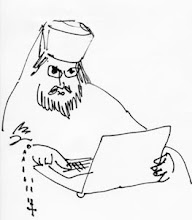 The following is a brief article by Fr Andrew Louth on iconography written for the general public. It appeared in New Statesman on June 7, 2007, as part of "The Faith Column" series, to which he contributed four columns:
The following is a brief article by Fr Andrew Louth on iconography written for the general public. It appeared in New Statesman on June 7, 2007, as part of "The Faith Column" series, to which he contributed four columns:If you go into an Orthodox church, what is perhaps most striking is the multitude of pictures to be seen.Everywhere you look there are pictures—icons—mostly painted, though in some churches there may be mosaics, too. The walls, the dome, the apse, the ceilings are all painted with depictions of Christ and the saints; in the church there may be stands bearing individual icons; and stretching across the church, there is an icon-screen sealing off the sanctuary from the main body of the church.
The icon-screen, or iconostasis, has rows of icons: icons of Christ and the Blessed Virgin, or as we call her the Mother of God, either side of the central doors. They are flanked by other saints, John the Baptist and the patron saint of the church and beyond that, figures of angels. Above, there are further rows sometime reaching up to the ceiling.
What is the point of this plethora of icons? Not that long ago, they were regarded as a primitive, stunted form of art in comparison with the art of the West. Fashions change, and now they are highly valued; over the last few decades there have been a number of important exhibitions of icons at the Metropolitan Museum in New York, the Victoria and Albert Museum and elsewhere. Though they are certainly works of art, often displaying great skill (the fifteenth-century Andrey Rublev was a painter of unparalleled genius), they are not primarily works of art, but objects of devotion. They belong to the context of prayer: both the public prayer of the church, during which they are solemnly censed, and also in private devotion. It is customary for Orthodox households to have a place set apart for prayer which is an ‘icon corner’ (the ‘beautiful corner’, as the Russians call it) where there are icons with lamps burning before them. In praying before icons, we bow to them and kiss them. What is the point?
First of all, they are tangible, material objects. Orthodox Christianity believes in the goodness of God’s creation; we are beings of flesh and blood, as well as soul and spirit; the material creation, though marred by the Fall.
Secondly, icons express aspects of the faith in pictorial form: in teaching, one picture is often worth a thousand words.
Thirdly, the most striking aspect of the icon is the depiction of the face; as we look at the icon, we encounter the loving gaze of the face of Christ, or the Mother of God, or one of the saints. The icon is often called a door: a door into the world of Christ and the saints, who live transfigured by the light of the Resurrection. Unlike Western paintings from the Renaissance (before the rise of modernism) the icon is not a window on to the familiar world of buildings and fields, rather its perspective is reversed, so that the figure in the icon seems to move towards us and draw us into the world he or she inhabits. Again, in icons of Christ, it is the human face of God we encounter: the face of one who took flesh for our sake, who became recognizable as a human being, who became ‘one of us’.
The icon then reminds us of the truth of the Incarnation.
Furthermore, the word ‘icon’ means ‘image’. We, and all human beings are created ‘in the image of God’. So, we are to regard all humans as ‘icons’ of God, through whom we encounter the divine—as precious beings we should reverence, just as we bow down before an icon.
The above photograph depicts the iconostas of the Russian Orthodox Cathedral of St John the Baptist in Washington, DC.
For my brief summary of the theology of the icon, go here.









No comments:
Post a Comment